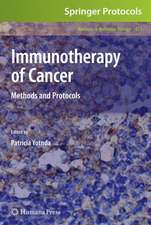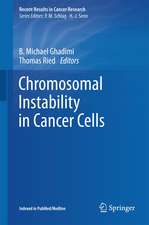The Beginnings of Cancer in the Cell: An Interdisciplinary Approach
Autor Janos Ladik, Wolfgang Förneren Limba Engleză Paperback – 14 dec 2011
The approach of this book is interdisciplinary. Theoretical models are qualitatively applied. Known effects, like oncogene activation, anti-oncogenes, and disturbances of the cell's self-regulation are explained. The authors propose possible points of intervention in the cancer initiation process based on the theoretical considerations.
Preț: 383.12 lei
Nou
Puncte Express: 575
Preț estimativ în valută:
73.32€ • 79.61$ • 61.59£
73.32€ • 79.61$ • 61.59£
Carte tipărită la comandă
Livrare economică 22 aprilie-06 mai
Preluare comenzi: 021 569.72.76
Specificații
ISBN-13: 9783642789861
ISBN-10: 3642789862
Pagini: 208
Ilustrații: VII, 194 p.
Dimensiuni: 155 x 235 x 11 mm
Greutate: 0.3 kg
Ediția:Softcover reprint of the original 1st ed. 1994
Editura: Springer Berlin, Heidelberg
Colecția Springer
Locul publicării:Berlin, Heidelberg, Germany
ISBN-10: 3642789862
Pagini: 208
Ilustrații: VII, 194 p.
Dimensiuni: 155 x 235 x 11 mm
Greutate: 0.3 kg
Ediția:Softcover reprint of the original 1st ed. 1994
Editura: Springer Berlin, Heidelberg
Colecția Springer
Locul publicării:Berlin, Heidelberg, Germany
Public țintă
ResearchCuprins
Preface.- (The History of Cancer).- References.- 1 Do We Carry the Cause of Cancer in Our Genes?.- 1.1 Viral Cancer Causing Genes.- 1.2 Oncogenes in Plants and Animals.- 1.3 Human Cancer Causing Genes.- References.- 2 Activation of Cancer-Causing Genes (Biochemical Discussion).- 2.1 Activation of Oncogenes Through Mutations.- 2.2 Overactivation of Some Normal Genes.- 2.3 Other Biochemical Possibilities of Oncogene Activation.- References.- 3 The Role of External Factors in the Start of the Cancerous Change in a Cell.- 3.1 Different Cancer Initiating Chemical Compounds (Carcinogens) and Their Most Important Reactions in the Cell.- 3.2 The Role of Electromagnetic and Particle Radiation.- 3.3 Other Factors Involved in Cancer Initiation, e.g. Role of Trace Elements in the Cell, Heat or Continous Local Pressure.- 3.4 The Role of a Second Group of Chemicals: Cancer Promoters.- References.- 4 A Brief Summary of the Structure of DNA and Proteins and their Biological Role.- 4.1 The Chemical and Geometrical Structure of DNA and Proteins.- 4.2 The Biological Role of DNA and Proteins.- References.- 5 Mechanism of Oncogene Activation or Antioncogene Inactivation by External Factors.- 5.1 Carcinogens and Radiation Affect DNA Not Only Locally.- 5.2 Local Effects of Carcinogens and Their Effect on Oncogene Activation (Point Mutations).- 5.3 Different Long Range Physical Effects of Carcinogens.- 5.4 The Effects of Radiation on DNA.- References.- 6 The Disturbance of Cell-Self-Regulation Due to Oncogene Activation and Antioncogene Inactivation.- 6.1 Changes in Protein Structures and Concentrations Due to Oncogene Activation and Antioncogene Inactivation.- 6.2 Qualitative Description of a Mathematical Model for the Chemical Reactions Characterizing Living Cells and Their Ensembles.- 6.3 Model for a Cell with a Changed Stationary State (Initiation of the Cancerous State).- References.- 7 The Role of the Central Nervous System in the Malignant Transformation of Cells in Higher Organisms.- References.- 8 What Should Be Done.- 8.1 Introduction.- 8.2 Some Cancer-Cell-Specific Curative Methods.- 8.3 Developments in Early Tumor Detection.- 8.4 Possibilities of Prevention of Cancer.- References.- Appendix: Outlines of a More General Theory of Cancer Initiation in the Cell.- A.1 Introductory Remarks.- A.2 Proteins as Good Disordered Amorphous Semiconductors.- A.3 The Normal and Cancerous State of Living Matter.- References.















